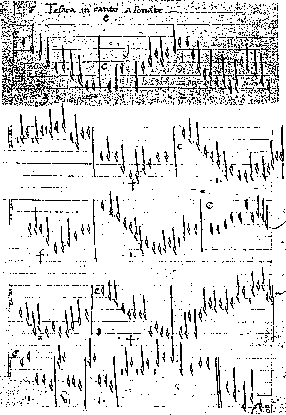Tesara, by Domenico. Six men and four women. Difficulty = Level 4
| Steps: | Doppio (in 4), Saltarello (in 6), Piva (in 6), Meza Ripresa (in 3 [in Section II] and in 6 [in section 6]), Mezavolta, Movimento. |
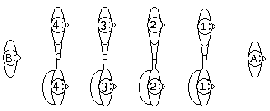
Starting Position |
| Start: | Everyone is facing up the hall. Man A is at the front of the group, and behind him, each spaced three steps behind the next, are Couple 1, Couple 2, Couple 3, Couple 4, and Man B. Each couple holds hands and starts about two steps apart (wide enough for a person to stand between them), with the woman on the right. The eight dancers in couples have a ribbon each, held in their free hands. (Strips of cloth about 45 by 12 inches work well for the ribbons.) The ribbons can be moved around and held in either hand, as desired by the dancers. When the ribbon needs to be in a particular hand, this will be mentioned. |
| Music: | The dance is done in 6/8 throughout, but the speed changes in different sections depending on whether the original section was in saltarello time or piva time (which is faster). We have indicated this difference in the section headers by noting the music as being either in 6/8 or in (faster) 6/8, while the music is marked with saltarello or piva. |
| Section I (3 bars in 6/8, three times) |
1-3
(3 times) | 1 bar of Introduction and 8 Saltarelli, starting Left. |
| Section II (11 bars (faster) 6/8, played twice) |
| 4 | Couples separate with a half-bar Meza Ripresa, Men Left, Women Right, |
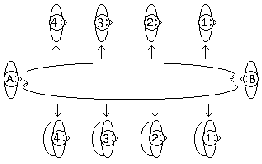
Bar 4 and Bars 5-8 (1st time) |
| as | Man A ends with a Mezavolta Right.
(There is now an empty passage in the middle of the set, just wide enough for two men to pass each other. Man A is facing down the hall, toward Man B, while everyone else is still facing up the hall.) |
| 5-8 | Man A and Man B Piva Left, Piva Right, Piva Left, Piva Right, ending with a Mezavolta Right, passing right shoulders and ending in each other's places. |
| 9-10 | Couples change places with partners, doing 4 Meza Ripresa (each taking a half-bar), Men going Right passing in front of their partners as Women go Left. (Man A is at the bottom and Man B at the top, facing each other. Couples are all facing up the hall, Men on the right now instead of the left, spaced about two steps apart.) |
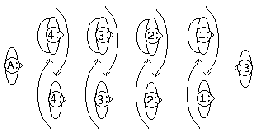
Bars 9-10 (1st time) |
| 11-12 | Men 1-4 each do a Movimento, one after the other. |
| 13-14 | Women Movimento, one after the other, in the reverse order (starting with Woman 4.) |
4
(2nd time) | Couples separate with a half-bar Meza Ripresa, Men Right, Women Left. |
5-8
(2nd time) | Man A and Man B Piva Left, Piva Right, Piva Left, Piva Right, ending with a Mezavolta Right, passing right shoulders and ending in each other's places. |
9-10
(2nd time) | Couples change places with partners, doing 4 Meza Ripresa, (each taking a half-bar), Men going Left passing in front of their partners as Women go Right. (Man A is at the top and Man B at the bottom, facing each other. Couples are all facing up the hall, Men on the left again, spaced about two steps apart.) |
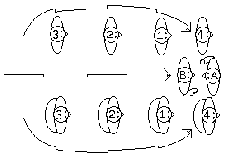
Bars 15-17 (four repeats, 1st time) |
| 11-12 | Men 1-4 each do a Movimento, one after the other. |
| 13-14 | Women Movimento, one after the other, in reverse order. (The men should have their ribbons in their right hands, while the women have them in their left.) |
| Section III (3 bars in (faster) 6/8, four times, + 5 bars in (faster) 6/8, all of this played twice) |
15-17
(4 times) | Man B takes one end of Man 4's ribbon and one end of Woman 4's ribbon. Man B and Couple 4 do the following sequence four times, alternating feet, the first time starting on the Left:
(A doppio, closing the feet, taking two bars)
Bar 15, 1st half = Step Left,
Bar 15, 2nd half = Step Right,
Bar 16, 1st half = Step Left,
Bar 16, 2nd half = Put Right foot beside left, without changing weight,
(A meza ripresa, taking one bar.)
Bar 17, 1st half = Step sideways Right,
Bar 17, 2nd half = Place Left toes under right heel.
(The next sequence starts on the Right.)
While doing this, Man 4 goes up the left side of the men's line, ending three steps ahead of Man 1, Woman 4 goes up the right side of the women's line, ending three steps in front of Woman 1, and Man B goes up the middle. The ribbons being held by Man 4, Man B, and Woman 4 form arches over the other dancers as these three advance. At the top Man B drops the ribbons.
(Couple 4 is now ahead of Couple 1. Man B is facing Man A.) |
| 18-19 | Man A and Man B take right hands and switch places with 2 Pive, Man B starting on the Left foot, Man A starting on the Right. |
| 20-22 | Man A goes to the bottom with 3 Pive, starting Right, ending with a Mezavolta Right. (Man B is at the top of the set, three steps ahead of Couple 4. Behind Couple 4 are Couple 1, Couple 2 and Couple 3, with Man A behind them. Man B is facing down the hall, while the rest are all facing up.) |
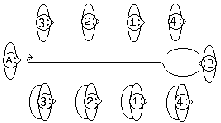
Bars 18-22 (1st time) |
| 15-17 | (4 more times) Man A and Couple 3 move up to the top, as Man B and Couple 4 did. |
18-22
(2nd time) | Man A and Man B switch places, and Man B returns to the bottom, as before. (Man A is at the top, facing down the hall. The rest are facing up the hall, Couple 3 in the lead, then Couple 4, Couple 1, Couple 2, and Man B at the bottom.) |
| Section IV (6 bars in 6/8, twice) |
| 23-25 | Man B and Couple 2 move up as in Bars 15-17, but using 3 Saltarelli, starting Left. |
| 26 | Man B and Man A Saltarello Right, taking right hands and switching places. |
| 27-28 | Man A Saltarello Left, Saltarello Right to the bottom, ending with a Mezavolta Right. (Man B is at the top, facing down the hall. The rest are facing up the hall, Couple 2 in the lead, then Couple 3, Couple 4, Couple 1, and Man A at the bottom.) |
23-28
(2nd time) | Repeat, Man A and Couple 1 moving to the top, and Man B ending at the bottom. (Everyone is back to his starting position, Man A in the lead, facing down the hall, the rest facing up the hall. Dancers with ribbons should all have them in their left hands.) |
| Section V (4 bars in (faster) 6/8, four times) (Two bars are danced to as if one bar in 4/4 ) |
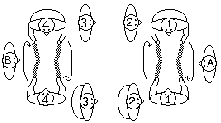
Bars 29-30 (1st time) |
| 29-30 | Outside Couples (Couple 1 and Couple 4) take the end of their partner's ribbons with their right hands, and forming an arch with the two ribbons, switch places with partner (pass right shoulders) with a Doppio Right ending with a Mezavolta Right. (Man 1 and Man 4 are on the Women's side, and their partners are on the men's side. Couple 1 are making an arch with their two ribbons, as are Couple 4.) |
| 31-32 | Man A and Man B Doppio Left, and bring Right foot beside left ending with weight on both feet. Man A passes under Couple 1's arch, Man B under Couple 4's. (Man A is between Couple 1 and Couple 2, Man B is between Couple 3 and Couple 4.) |
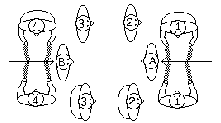
Bars 31-32 (1st time) |
29-30
(2nd time) | Inside Couples (Couple 2 and Couple 3) Doppio Right, ending with a Mezavolta Right, making an arch and switching places as Outside Couples did. |
31-32
(2nd time) | Man A and Man B Doppio Left, and bring Right foot beside left, Man A passing under Couple 2's arch, Man B under Couple 3's. (Man A and Man B are both between Couple 2 and Couple 3, right shoulders together, Man A facing down the hall, and Man B up.) |
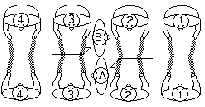
Bars 31-32 (2nd time) |
29-30
(3rd time) | Inside Couples switch places, as before, still holding up their ribbons. They should end as far apart as possible. |
31-32
(3rd time) | Man A and Man B pass under the next arch, as before, Man A passing under Couple 3's arch, Man B under Couple 2's. (Inside Couples are now back on their original sides, still holding up their ribbons to form arches. Man A is between Couple 3 and Couple 4 while Man B is between Couple 1 and Couple 2.) |
29-30
(4th time) | Outside Couples switch places, as before, still holding up their ribbons. They should end as far apart as possible. |
31-32
(4th time) | Man A and Man B pass under the last arch with a Doppio Left, ending with a Mezavolta
(Step Right, turning clockwise).
(The couples are all back in their places, but spaced farther apart than they started, still holding up their ribbons. Man A is at the bottom of the set, facing up, while Man B is at the top, facing down.) |
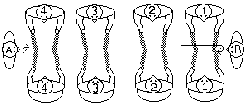
Bars 31-32 (4th time) |
| Section VI (5 bars in (faster) 6/8) |
| 33-36 | Men A and Man B 4 Pive, starting Left, passing right shoulders, going under the ribbons back to their places, ending with a Mezavolta Right. Couples drop their partners' ribbons. |
| 37 | Men 1-4 Mezavolta (Step Left, Step Right, turning three-quarters of a circle, counterclockwise), |
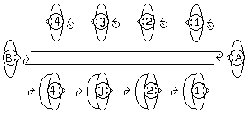
Bars 33-36 and Bar 37 |
| as | Women shift slightly to face up the hall. (Man A and Men 1-4 are facing down the hall, while the rest are facing up. The dancers are, more or less, facing counterclockwise around a large oval.) |
| Section VII (4 bars in 6/8, four times) |
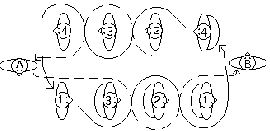
Bars 38-41 (1st time)
(Paths of Man A and Man B are dashed lines,
while those of Man 1 and Woman 4 are solid.) |
| 38-41 | Man A, Man B, the last man in the men's line (Man 1, this time) and the last woman in the woman's line (Woman 4, this time) do 4 Saltarelli, starting Left, each moving counterclockwise to a position exactly halfway around the oval: Man A and Man B switch places and Man 1 and Woman 4 switch places. As they move they weave around the three stationary people in front of them (Man A and Man 1 around Man 2, Man 3 and Man 4, and Man B and Woman 4 around Woman 3, Woman 2 and Woman 1). Man A and Man B start by going to the left of the first person that they weave around, and Man 1 and Woman 4 start to the right of the first person that they weave around.
(The 10 dancers are facing counterclockwise around the oval. Man B is at the top of the set, Woman 4 (on the Men's side) and Woman 1 are next, then Man 2 and Woman 2, then Man 3 and Woman 3, then Man 4 and Man 1, and Man A is at the bottom of the set.) |
38-41
(2nd time) | Repeat, but Man 2 and Woman 3 (who are both currently the last members of their gender on their own sides of the oval) weave instead of Man 1 and Woman 4, still starting to the right sides of the people in front of them. The four dancers are still moving counterclockwise, but the people that they are weaving around and therefore the paths they take, will be slightly different.
(Now Man A and Man B are back home. What used to be the men's line now has Woman 4 (at the top of the hall), Woman 3, Man 3 and then Man 4, all facing down the hall, while the women's line has Woman 1, Woman 2, Man 2, Man 1, all facing up the hall.) |
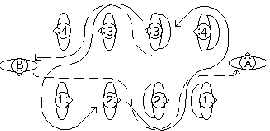
Bars 38-41
(2nd Time) |
38-41
(3rd time) | Repeat, Man A, Man B, Man 3 and Woman 2 weaving. |
38-41
(4th time) | Repeat, Man A, Man B, Man 4 and Woman 1 weaving.
(Man A is at the top of the set, and Man B is at the bottom. The couples have all rotated half-way around the circle from their original positions, so Couple 4 is now at the top and Couple 1 at the bottom, with the men on the women's side. The men are facing up the hall, and the women down.) |
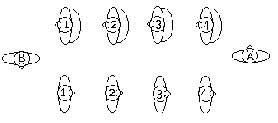
Position at End of Section VII |
| Section VIII (6 bars of (faster) 6/8) |
| 42-43 | Men 1-4 each do a Movimento, one after the other. |
| 44-45 | Women Movimento, one after the other, in the reverse order. |
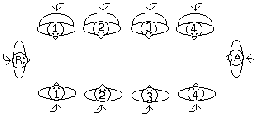
Bar 46 and Bar 47 |
| 46 | All six Men Step Left, Step Right, turning counterclockwise to face into the circle |
| 47 | Women Step Left, Step Right, turning counterclockwise to face into the circle. |
Recordings
Forse - Extra one-bar introduction. Works with this reconstruction.
To Celebrate - Half-bar extra introduction. Works with this reconstruction. Dance repeats, so we suggest having the set turn around to face down the hall with Man B leading the second time.
Dance Notes
Start: The separation between partners is not given, so two steps apart is a guess. That distance is given for the end of Bar 10; and it may actually be shorter at the beginning, but having the two distances be the same works well.
There is no instruction given for which hand to hold the ribbon in at the beginning, but the outside hand is logical. We presume that the ribbons could be moved around as desired, except where it is particularly specified.
Bar 2: No starting foot is given.
Section II: The timing of the steps is uncertain. There are eleven bars of music in piva misura, in which are done a ripresa (unless it is done at the end of the preceding bar), a mezavolta by Man A, four pive, four meze riprese, and a series of movimenti. Bars 11-14 matches Bars 42-45, where a similar sequence of movimenti are performed, so that much music is accounted for. The pive must use up four bars, which leaves only three. In other dances meze riprese take a full bar each, but here there is insufficient music, so we assigned them only half a bar each. The remaining bar we decided was at the start of the section, and would have the lone ripresa, which, as the couples are instructed to do it "presto", we decided was another meza ripresa, the presto being necessary both to indicate that it was done in less than a bar, and perhaps to show that it was a meza ripresa, rather than a normal one.
We had also considered that this lone ripresa might be described as "presto" in order to indicate that it should be done at the end of the last bar of saltarello. That would be difficult with our reconstruction of the saltarello, however, as it would coincide with the hop, and would also mean that it would either be left out of the repeat, or done during the end of the movimenti, when not all of the women would be finished.
Bar 4: Man 1's mezavolta appears in PnD as a remark that Man A and B should face one another. We chose a one-beat mezavolta. It is unnecessary on the repeat, as they turn at the end of their piva sequence.
Bars 5-8: No side is given on which the men pass.
Bar 11-14 and 42-45: Exactly what occurs in these two places is unclear, but as the music matches they can be presumed to be the same. (This was pointed out by Peggy Dixon in Dances from the Courts of Europe, First Supplement (1989).) The first occurrence has "facendo li homi movimenti quatro poi le done ge rispundeno cun uno altro" while the second reads "facendo tutti gli omini in instanti uno movimento respondendo gli le done con uno altro". The second time clearly sounds as if the men are all performing one movimento at the same time, and then the women respond with one more. There are four bars of music, however, which would give two bars to each movimento. Half a bar is usual, and the amount of music here is sufficient for eight movimenti. This leads to the conclusion that what is meant is that the men each do a movimenti, one after another, doing all four of them, before the women respond with their one movimento each. The wording, while unclear, was perhaps attempting to make it obvious that the men should finish before the women start, rather than each woman responding to her partner before the next man does his movimento.
The order that the movimenti are done (aside from all the men doing them before the women) is not given. One obvious solution is that Man 1 and Woman 1 should be the first in their respective lines. We chose to have Man 1 begin, but decided to have Woman 4 be the first woman, so the movimento, as it were, travels around the circle. As well as matching the weave that we have in Section VII, it also means that Woman 4 is finished first, so that on the second repeat of Bars 11-14 she will be ready in plenty of time to have Man B take one end of her ribbon.
Bars 15-17: The step sequence is a little unclear. It is specified as each three pive being done with "dopio uno sul pe sinistro tirando el dritto apresso el senestro con una posa et fazanda una ripresa sul pe dritto". The choices are to either do a doppio in one bar and then do a full ripresa in two, or do a doppio in two bars (which is quite common) and give the ripresa only one. We chose the latter option, and decided that the ripresa is actually a meza ripresa, as it is only half a bar as are the earlier meze riprese. This also means that each sequence starts on alternating feet, which is not specified (and, if the instructions are taken literally, it may be specified exactly otherwise), but does prevent the dancers from drifting off to the right. The entire sequence becomes similar to a saltarello tedesco, done in slightly different time as it takes six beats rather than the usual four, and is done much
more slowly.
(It is also conceivable that the doppio and the ripresa take the same amount of time, being one and a half bars each.)
The exact meaning of posa is not certain, but we are using a close of the following foot (which in this case is specified beforehand, which may be reiteration or may indicate that this interpretation of posa is wrong), ending with weight on both feet, and, if there is time, a pause. Although shifting weight to both feet may be indicated in this case, and is perfectly possible, it is easier to step on the correct foot for the meza ripresa that follows if this is not done, so we have left it out. (For other dances that include a posa, see Sobria and Marchesana.)
Bars 18-19: There is no indication of what hand to use, what foot to start on, nor any mention of a mezavolta or what direction Men A and B should be facing when they finish this section. We added these details as seemed
correct.
Section IV: No starting foot is mentioned for the saltarelli, nor is a hand given, nor is a mezavolta actually specified. We have added these details.
Bars 29-30: PnD says that the outside couples should take the ribbons in their right hands. We decided that they are holding their own ribbons in their left hands, and take their partners' ribbons in their right. It may also be that both ribbons are held in the right hand, but this makes it more difficult to let go of only one, in Section VI, and we are presuming that each partner retains one.
No indication is given as to which way the partners pass each other, but as they do a mezavolta on the right it will be more natural to have passed right sides.
It's possible the doppio should take one bar, and the mezavolta should take the second, rather than both bars for the doppio, with the mezavolta added to the end. However, then the next section should also be a one-bar doppio, and one bar for the posa, which is possible but flows less well.
On the third and fourth repetition we added the instruction that the couples should end as far away as possible from their partners. This is more important than the first two times as the couples will not have a chance to widen any further before Men A and B have to charge back through the middle with pive, at greater speed than with the previous doppii, thus needing more room to dodge each other than before.
Bars 31-32: The men are to do a doppio on the left and a posa on the right. We have used a posa as we did earlier in the dance, bringing the right foot next to the left, but in this case leaving the weight on both feet. We are presuming that every time Man A and Man B do a doppio in this section it will be exactly the same, starting on the left (only the first is exactly specified, the rest being described as done in a similar manner), so ending with weight on both feet will leave the left foot free for the next doppio. It will also ensure that Men A and B have their trailing feet out of the way, on the second repeat, when Couples 2 and 3 are about to change places behind them.
The last repeat we have turned the posa into a step forward, so Man A and Man B can do a mezavolta. No foot or direction is given for this mezavolta, nor is it referred to as a mezavolta. It might instead belong with the piva that follows.
Bars 33-36: No starting foot or direction to pass in are given, nor are there details for the turn at the end, which is not called a mezavolta.
Bar 37: No details of this mezavolta are given , except that it is on the left and takes a tempo of piva. Because we wanted the dancers to start on the left foot for the saltarelli that follow, we decided to use two steps, but using a piva for instance, and then starting the saltarelli on the right would follow the source as accurately.
No mention is made of the woman turning to face up the hall. For a discussion of the reasoning behind this addition, and the amount that we chose to have the men turn, see the discussion of Section VII.
Section VII: As usual, the exact details of what is occurring are uncertain. There are four repeats of a four-bar phrase, and in each repeat Man A, Man B, one of the women, and one of the other men snake around three of the stationary dancers. It is clear that Man A goes down the men's line the first time, and Man B goes up the women's line, and, as there is no mention of them turning around at the end, it can be presumed that they continue to weave
around the set in a counterclockwise direction, making two complete circuits.
Which man and which woman move the first time is less certain, but as they are described as the last couple ("la dredrava copia"), and the woman's path is specified as snaking around the three woman who are in front of her, it is clear that these two dancers are the ones at the bottom of their respective lines. The uncertainty lies in which way the dancers are facing as they start this section.
In the previous bar the four men, only, are told to do a mezavolta. This suggests that the men and women are now facing in opposite directions, so it is either Man 1 and Woman 4 who start, or Man 4 and Woman 1.
If they are all facing across the set before the men turn, as we have them in our reconstruction, a literal mezavolta will leave the men facing out of the set, and the women staring across the set at their backs. Our presumption is that the woman do actually turn slightly, in order to face up the set, guessing that it might not be mentioned as that would be their default position, while the men turn more than that, to the left, actually turning three-quarters of a circle, so that they end up facing down the set. Another way to accomplish the same thing would be to have the couples all end Section V by turning slightly to the front, and then have the men do a normal mezavolta.
One problem with our reconstruction is that the woman who is weaving is told to end in front of the other women. We are guessing that, because the group is now equivalent to an oval, Man 1's place is now "in front of" Woman 1, and that the place that Man A and Man B go into is ignored, but this is not entirely satisfactory. Another problem is that the paths of the couple who are weaving do not neatly avoid the paths of Man A and Man B, as they do the first time, or as they do if the couples start facing the same direction (which is discussed below).
One result of our reconstruction is that all four active dancers are circling the same way. A more interesting effect might be produced by having the men's line face up and the woman's line down, so it is Man 4 and Woman 1 who start, moving clockwise, while Man A and B move counterclockwise. In order to get the lines into this position, from our previous Section V, both the men and women have to do a quarter turn to the left, but, as only the men are told to turn, this seemed to us to be slightly less likely. Moving in opposite directions also makes the instructions regarding the paths less clear. In our chosen reconstruction, Men A and B move in the same direction as the lines are facing, so when they are told to move to the left or right side of a person they are passing it is quite clear. If the lines are facing clockwise instead, they would be moving to their own left when they are moving to the stationary person's right, and vica versa. The directions given would probably refer to the stationary person's sides, as otherwise Man A and B would be at risk of colliding with the couple who are also weaving.
Another possibility that we considered is that the couples start this section all facing in the same direction, so the set gradually moves forward (or backward), much as it did in Section III. This has the advantage that it literally obeys the instruction that the woman should end in front of the other woman, rather than having her actually at the end of the men's line. Getting into this position would be slightly more difficult to arrange, as it would mean that the men's mezavolta must turn them so that they are facing the same way as the women. Previous to the mezavolta they would have to be facing in opposite directions, which we do have them doing, but in such a way that the women are already lined up in single file. Section V seems to clearly end with the couples facing each other, as each doppio used to change places ends with a mezavolta, but it could be that the mezavolta is only a quarter turn, so that the woman ends the section facing down the set, and the men up. Another possibility is that the doppio used to change places is done on a curved path, so the first time the dancers end with the women facing up and the men down, but they then do a mezavolta so that the women face down and the men up. The next time those dancers switch they then rotate in the opposite direction, again ending in a mezavolta, so the women are facing down and the men up. The mezavolta of Bar 37 would then bring the men around to face down the hall. In order to end with the couples all facing up the hall, it is only necessary to reverse this by having the couples pass left shoulders the first time, in Section V
If the couples do start Section VII facing the same direction, then the last couple will actually be a couple, (rather than Man 1 and Woman 4, for instance), though it might be Couple 1 or Couple 4 depending which way they face. The drawback to this method is that, although the couples are fine, merely moving up to the top of their lines, Man A and Man B have paths that are of considerably different sizes and would be awkwardly speeding up while going up the set, and then slowing down when they go down it. (As an example, if Couple 4 are the first ones to move, the first time Man A would only have to go past Man 1, Man 2, Man 3, and then stop behind and between Couple 3, while Man B would have to go past where Woman 4 had been, go around Woman 3, Woman 2 and Woman 1, and then get in front of Woman 4.) Because Man B is instructed to end ahead of the couple in front, while Man A is told to end between the last couple, this might be evidence to support a setup where the lines have turned to face down the hall, Man 1 and Woman 1 moving first. But the wording becomes very awkward, as ahead would still mean to the original top of the hall, despite the couples moving the other way.
The main advantage to this method is that the paths of the dancers are always clearly logical, as no one ever switches sides. In our reconstruction, because of the couples having to cross over to the other side, their paths do not always stay the same, nor are they always opposite the paths of Man A and B.
Bar 38: No starting foot is given. We decided on left as our default value.
Bars 42-45: See note for Bars 11-14
Bars 46-47: PnD says that all of the men do a mezavolta on the left and then the women respond with another (literally, "respondeno con meza altra".) If this is really a half-turn the dance would end with everyone facing around a circle, so we decided to have them only do a quarter-turn to face into the center, and did not call it a mezavolta to avoid confusion.
If the previous section is done with all the couples facing the same way, instead of opposite as we have it, then the mezevolte merely has the set change direction, possibly for a repeat of the dance. For a repeat (presuming that the couples had been facing up the hall and had turned to face down) Man B would also have to turn around in order to lead the set, but Man A would not.
The instruction is for all of the men to make the mezavolta, but this may mean all of the men who are in couples. The previous movimenti are also to be done by all the men, and that presumably matched Bars 11-12, where we believe the four movimenti that the men make means it is just the four men in couples. In order to have all the men face into the circle, however, we decided that this really does refer to all six of the men.
No details of the mezavolta are given, except that it is on the left, so we used the same two steps as we did in Bar 38. We show considerable inconsistency, however, as in Bar 38, we reasoned that the woman's mezavolta was too small to mention, but here have the dancers turn the same quarter-turn as the women did there.
Music Notes
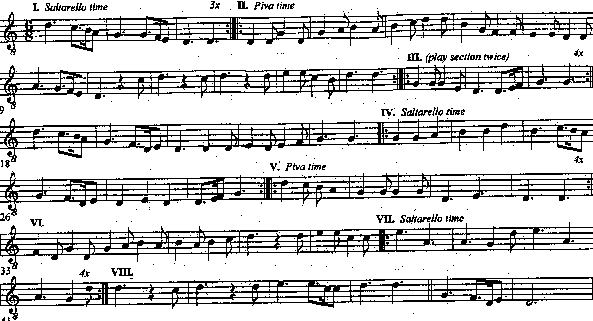
A number of judgment calls were required with this music, particularly in the handling of the phrases including dotted minimae. In the beginning of the music these are notated "correctly" (to produce the syncopated eighth-sixteenth-eighth sets seen frequently in this music); at several points later in the music, the trailing minima is sometimes replaced with a semibrevis. A literal interpretation in those places would produce irregular music, so we adjusted these as a matter of policy everywhere they appeared.
When phrases began with minimae, we generally treated them as pickups from the previous bar, as this interpretation made for easier dancing. In Section VIII, it was necessary to drop an opening rest to follow this rule. It is possible that, instead, the first 3 bars of that section were meant to begin with dotted quarter rests, but we found this interpretation unlikely.
In Section IV, PnD provided 6.5 bars of music but only 6 bars of choreography. We shortened the phrase; the original was as follows:

We have Bars 38-41 marked as "4x". In the manuscript, the last two of these are marked "vi" and preceded by 3 bars of music that are almost identical to this phrase except for the note durations. The dance calls for 16 bars of music, which works with our interpretation. We could not find an interpretation of the steps that fit with 17 bars of music, and the two-bar rhythmic pattern was too likely to be easily dismissed.
The transcription we have given above actually contains one minor fiction, which we introduced to make it easier for dancers to match the music to the steps. Section VII is really as follows, and the arrangement in this book reflects the correct version. (The final eighth note is different the last time through.)

We doubled the length of the final note of the piece so it could fill a bar.
We have provided the music from PnD for comparison and study.
